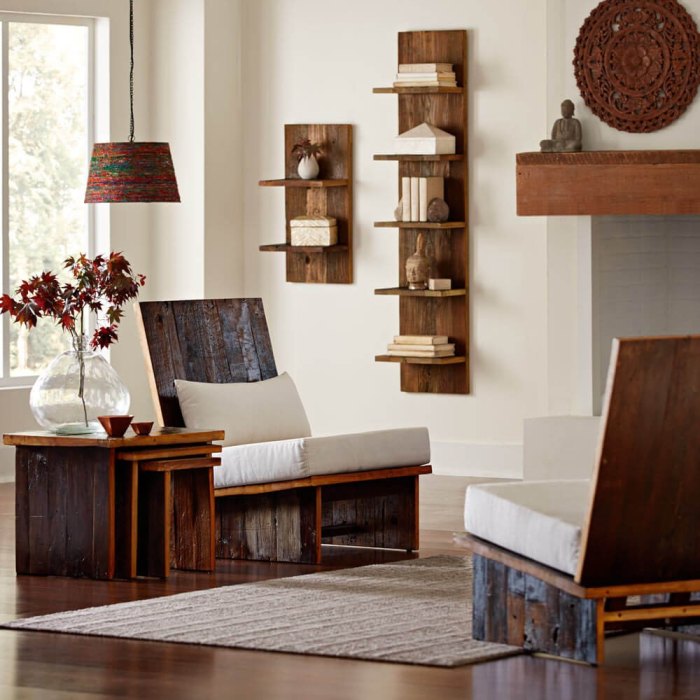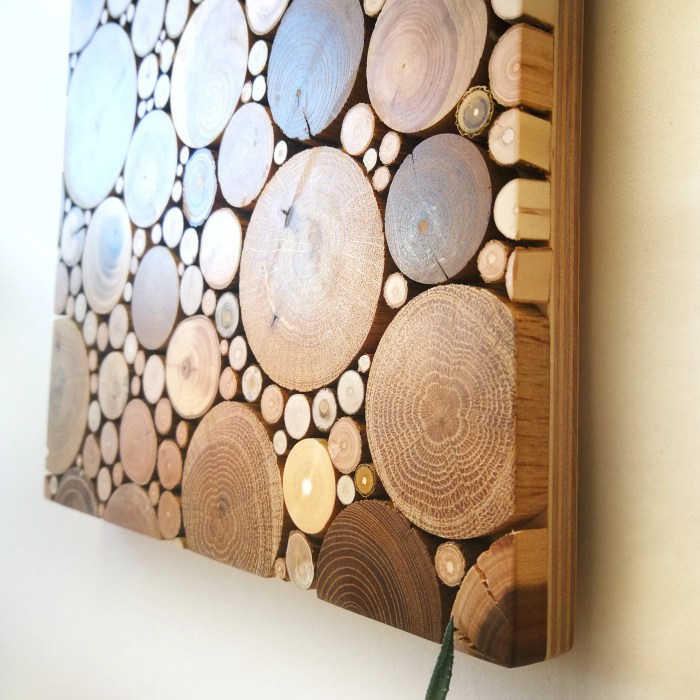Types of Wooden Wall Decor

Wall decor made of wood – Wooden wall decor offers a versatile and timeless way to enhance your home’s aesthetic appeal. From rustic charm to modern minimalism, the possibilities are endless. The choice of wood type, design, and style significantly impacts the overall look and feel of your space. Let’s explore the diverse world of wooden wall art and the options available to you.
Wooden Wall Decor Styles and Wood Types
Choosing the right wood for your wall decor is crucial in achieving the desired aesthetic. The following table compares different types of wooden wall decor, highlighting their typical styles and commonly used wood types.
| Type of Decor | Style | Wood Type | Example |
|---|---|---|---|
| Shelves | Rustic, Modern, Minimalist | Reclaimed wood, Pine, Oak, Walnut | A set of three floating shelves made from reclaimed barn wood, showcasing a rustic aesthetic; sleek, minimalist shelves crafted from light oak; a modern, geometric shelf unit built from dark walnut. |
| Clocks | Rustic, Modern, Farmhouse | Pine, Oak, Mahogany | A large, rustic clock with exposed wood grain and visible knots; a minimalist clock with a clean, geometric design in light oak; a farmhouse-style clock with a distressed finish in painted pine. |
| Artwork | Rustic, Modern, Abstract | Various hardwoods, Plywood | A carved wooden sculpture depicting a stylized animal; a modern geometric panel made from layered plywood; an abstract piece crafted from various hardwoods, showcasing contrasting textures and colors. |
| Signs | Rustic, Farmhouse, Shabby Chic | Reclaimed wood, Pine, Painted wood | A hand-painted sign with a vintage font on reclaimed wood; a simple, minimalist sign with a modern font on pine; a distressed, whitewashed sign with a floral design on painted wood. |
Advantages and Disadvantages of Different Wood Types
The properties of various wood types significantly influence their suitability for wall decor. Understanding these advantages and disadvantages helps in making informed decisions.Oak: Oak is a durable hardwood known for its strength and beautiful grain patterns. Advantages include its longevity and resistance to wear and tear. However, it can be expensive and requires more effort for finishing.Pine: Pine is a softwood, readily available and relatively inexpensive.
It’s easy to work with, making it ideal for DIY projects. However, it’s less durable than hardwoods and prone to scratches and dents.Walnut: Walnut is a luxurious hardwood prized for its rich, dark color and beautiful grain. It’s highly durable and adds a touch of elegance to any space. However, its cost is significantly higher than other wood types.Reclaimed Wood: Reclaimed wood adds character and sustainability to your decor.
It offers unique textures and patterns not found in newly milled wood. However, sourcing and preparing reclaimed wood can be time-consuming and may require specialized skills.
Unique and Innovative Wooden Wall Decor Designs, Wall decor made of wood
Beyond the conventional options, several innovative wooden wall decor designs are emerging. These designs often combine traditional woodworking techniques with modern aesthetics.Examples include intricate laser-cut wooden wall panels creating geometric patterns or silhouettes, 3D wooden wall art featuring layered designs with varying depths and textures, and wooden wall installations incorporating natural elements like moss or dried flowers, integrated into the wood design.
These designs often transcend the boundaries of simple shelves or clocks, becoming statement pieces in themselves.
Manufacturing and Production: Wall Decor Made Of Wood

Crafting stunning wooden wall decor involves a fascinating journey from raw material to finished masterpiece. This process, whether undertaken by a small artisan or a large factory, requires precision, skill, and a keen eye for detail. Let’s delve into the specifics of bringing a simple wooden wall shelf to life.Creating a wooden wall shelf, for example, begins with careful material selection.
The choice of wood significantly impacts the final product’s durability, appearance, and cost. Hardwoods like oak or maple offer superior strength and a rich grain, while softer woods like pine are more affordable and easier to work with. The desired aesthetic also plays a role; a rustic look might call for reclaimed wood, while a modern design might benefit from a sleek, stained finish on a more uniform wood.
Material Selection and Cutting
Choosing the right wood is paramount. Consider factors like the wood’s hardness, grain pattern, and cost. For a wall shelf, a stable, relatively lightweight wood is ideal. Once selected, the wood is measured and cut to the desired dimensions. This often involves using tools like a miter saw for precise angles or a circular saw for straight cuts.
Accurate cutting is essential for a structurally sound and aesthetically pleasing shelf. Pre-cut lumber from home improvement stores can also be a convenient option for simpler projects.
Sanding and Finishing Techniques
After cutting, the raw wood pieces require thorough sanding to achieve a smooth surface. This process typically involves using progressively finer grits of sandpaper, starting with a coarser grit to remove imperfections and gradually moving to a finer grit for a smooth, polished finish. Proper sanding prevents splintering and ensures a uniform surface for the finish.Various methods exist for applying finishes to wooden wall decor.
The warm grain of wood, a comforting presence in any home, lends itself beautifully to wall decor. From rustic shelves to intricately carved panels, wood offers a timeless appeal. For a romantic touch, consider incorporating Valentine’s Day themes, perhaps finding inspiration from websites specializing in valentines day wall decor , then crafting your own wooden heart or incorporating red and pink accents into your existing wooden pieces.
The result? A uniquely personal and enduring display, showcasing the versatility of wood as a decorative medium.
Painting offers a wide range of colors and can completely transform the wood’s appearance, creating a bold, modern statement. Staining, on the other hand, penetrates the wood, enhancing its natural grain and color while maintaining a more natural feel. Varnishing provides a protective layer that enhances the wood’s natural beauty and protects it from moisture and wear. Each method offers a unique aesthetic and level of protection.
For instance, a dark stain on oak would highlight its rich grain, whereas a bright, glossy paint would create a completely different, contemporary look.
Assembly and Mass Production vs. Handcrafted Methods
The final step in creating the wall shelf involves assembling the individual pieces. This may involve using wood glue, screws, or a combination of both, depending on the design and the desired strength. Accurate measurements and precise joinery are crucial for a sturdy and visually appealing shelf.Mass production techniques, often employed by larger manufacturers, utilize machinery to automate many stages of the process, including cutting, sanding, and finishing.
This allows for high-volume production at a lower cost per unit but may compromise the unique character and craftsmanship of handcrafted pieces. Handcrafted methods, conversely, involve meticulous attention to detail and often incorporate unique design elements, resulting in one-of-a-kind pieces with a higher perceived value. The choice between these methods depends on factors such as budget, desired aesthetic, and the scale of production.
A small-scale artisan might focus on intricate details and unique designs, while a large furniture manufacturer prioritizes efficiency and cost-effectiveness.
Care and Maintenance

Keeping your wooden wall décor looking its best is easier than you think! With a little care and attention, you can ensure your beautiful pieces remain a focal point in your home for years to come. Regular cleaning and preventative measures are key to preserving their natural beauty and protecting them from damage.Proper cleaning and maintenance techniques vary depending on the type of wood and finish.
Understanding these differences will help you extend the life of your wooden wall art and keep it looking stunning.
Cleaning Wooden Wall Decor
Different types of wood require different cleaning methods. For example, delicate carvings might need gentler treatment than a robust, solid wood piece. Always test any cleaning solution on an inconspicuous area first to ensure it doesn’t damage the finish. Avoid abrasive cleaners and harsh chemicals, as these can scratch or dull the wood’s surface.
- Dusting: Regularly dust your wooden wall décor with a soft, dry cloth or a feather duster. This prevents dust buildup, which can dull the finish over time.
- Spot Cleaning: For minor spills or marks, gently wipe the affected area with a slightly damp (not wet) cloth. Immediately dry the area thoroughly with a clean, dry cloth to prevent water damage.
- Deep Cleaning: For a more thorough cleaning, use a mixture of mild dish soap and warm water. Apply this solution sparingly with a soft sponge or cloth, gently wiping the surface. Rinse with a clean, damp cloth and dry immediately.
- Specialized Cleaners: For heavily soiled or finished wood, consider using a wood cleaner specifically designed for the type of finish on your décor. Always follow the manufacturer’s instructions.
Preventing Damage to Wooden Wall Decor
Protecting your wooden wall art from damage is crucial for maintaining its quality. Understanding common threats and implementing preventative measures will help keep your décor looking its best.
- Avoid Direct Sunlight: Prolonged exposure to direct sunlight can cause fading and discoloration. Position your wooden wall décor away from direct sunlight or use UV-filtering window treatments.
- Prevent Scratches: Handle your wooden wall décor with care. Avoid dragging or bumping it against other objects. If you need to move it, do so carefully and consider using protective padding.
- Protect from Moisture: Avoid placing your wooden wall décor in humid areas or near sources of water. Excessive moisture can cause warping, cracking, and mold growth. In bathrooms or kitchens, consider using a sealant or protective coating.
- Maintain Proper Temperature: Extreme temperature fluctuations can also damage wood. Avoid placing your décor near heating or cooling vents.
Protective Coatings for Wooden Wall Decor
Applying a protective coating can significantly enhance the longevity and beauty of your wooden wall décor. Different coatings offer varying levels of protection and aesthetic effects.
- Polyurethane: A popular choice, polyurethane offers excellent protection against scratches, water damage, and UV rays. It comes in various finishes, from matte to high-gloss.
- Shellac: A natural resin-based coating, shellac provides a beautiful, warm finish while offering some protection. It’s less durable than polyurethane but offers a more traditional look.
- Wax: Wax provides a protective layer and enhances the wood’s natural beauty. It’s easy to apply and can be reapplied as needed, but offers less protection than polyurethane or shellac.
Remember to always follow the manufacturer’s instructions when applying any protective coating. Proper application ensures the coating adheres correctly and provides maximum protection.
Expert Answers
What are some common problems with wooden wall decor?
Common issues include scratches, water damage, fading from sunlight, and warping due to humidity changes.
How often should I clean my wooden wall decor?
Dust regularly with a soft cloth. For deeper cleaning, use a slightly damp cloth and mild soap, ensuring it’s thoroughly dried afterward.
Can I use harsh chemicals to clean wooden wall decor?
No, avoid harsh chemicals as they can damage the finish and the wood itself. Use mild soap and water.
How can I prevent fading in my wooden wall decor?
Avoid direct sunlight exposure. Use UV-protective coatings or keep the piece out of direct sunlight.
